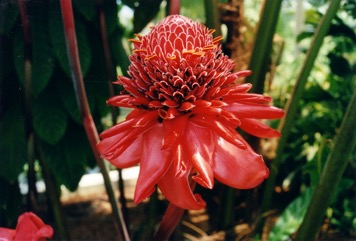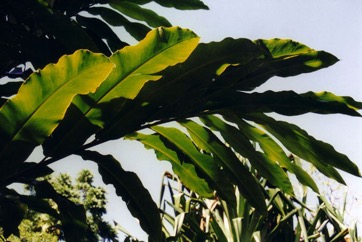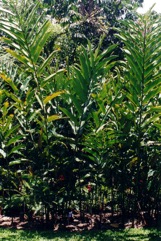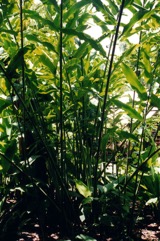Red torch Ginger, Philippine waxflower

A tropical plant. It suits places with a seasonally moist and dry climate or a continuously moist climate. It needs a fertile, humus-rich, well-drained soil. It suits bright shade. In China it is cultivated as an ornament. It suits hardiness zones 10-12. At MARDI. In Yunnan. In the Cairns Botanical Gardens.
Also known as:
Bua salleh, Bunga kantan, Chumbrang, Combrang, Dalaa, Ginger flower, Honje, Huo ju jiang, Kaalaa, Kantan, Kecala, Kechala, Kechombrang, Kechumbrang, Kecombrang, Kelu, Kimcong, Kimcuang, Miebumienai, Ondje, Petikala, Plastic-pan, Potok, Sambuang, Tepus kampong, Ubud udat
Synonyms
- Alpinia latior Jack
- Alpinia speciosa (Blume) D.Dietrich (1839) not (Wendland) K.Schumann (1893)
- Alpinia magnifica Roscoe
- Amomum magnificum (Roscoe) Benth. & Hook.f. ex B. D. Jacks.
- Elettaria speciosa Blume
- Nicolaia elatior (Jack) Horaninow
- Nicolaia speciosa (Blume) Horaninow
- Phaeomeria speciosa (Blume) Koorders
- Phaeomeria magnifica K.Schum.
- Phaeomeria speciosa Koord.
- and others
Edible Portion
- Flower bud, Shoots, Leaves, Seeds, Vegetable, Flavouring, Fruit
Where does Red torch Ginger grow?
Found in: Africa, Asia, Australia, Caribbean, Central America, China, Costa Rica, Ghana, Hawaii, Honduras, Indochina, Indonesia, Malaysia, Marquesas, Mauritius, Mexico, Myanmar, North America, Pacific, Papua New Guinea, PNG, Philippines, Puerto Rico, SE Asia, Singapore, Sri Lanka, Thailand, Trinidad and Tobago, United States, West Africa
Notes: There are about 60-70 Etlingera species.
Status: The flowers are sold in markets.
Growing Red torch Ginger, Philippine waxflower
Cultivation: Plants can be grown by seed or division. It can be grown from sections of the rhizome that have formed shoots. They need to be spaced 1-2 m apart.
Edible Uses: The flowers have a spicy flavour. They taste similar to Vietnamese mint. The flowers are chopped and served raw as a vegetable. The unopened flower buds are eaten in Asia. They are used to flavour curries. The young shoots and flowers are eaten raw. The flowers can also be cut into small pieces and mixed with cooked dishes and curries. The fruit are sour and mixed with other vegetables for flavouring. The ripe seeds are eaten uncooked.
Nutrition Info
per 100g edible portion| Edible Part | Energy (kcal) | Protein (g) | Iron (mg) | Vitamin A (ug) | Vitamin c (mg) | Zinc (mg) | % Water |
|---|---|---|---|---|---|---|---|
| - | - | - | - | - | - |
Red torch Ginger, Philippine waxflower Photos




References
Andarwulan, N., et al, 2010, Flavonoid content and antioxidant activity of vegetables from Indonesia. Food Chemistry 121: 1231-1235
Arora, R. K., 2014, Diversity in Underutilized Plant Species - An Asia-Pacific Perspective. Bioversity International. p 103
Brickell, C. (Ed.), 1999, The Royal Horticultural Society A-Z Encyclopedia of Garden Plants. Convent Garden Books. p 421
Burkill, H. M., 1985, The useful plants of west tropical Africa, Vol. 5. Kew.
Burkill, I.H., 1966, A Dictionary of the Economic Products of the Malay Peninsula. Ministry of Agriculture and Cooperatives, Kuala Lumpur, Malaysia. Vol 2 (I-Z) p 1731
Chai, P. P. K. (Ed), et al, 2000, A checklist of Flora, Fauna, Food and Medicinal Plants. Lanjak Entimau Wildlife Sanctuary, Sarawak. Forestry Malaysia & ITTO. p 164
Chin, H. F., 1999, Malaysian Vegetables in Colour. Tropical Press. p 88
Ching, L. S. & Mohamed, S., 2001, Alpha-Tocopherol Content in 62 Edible Tropical Plants. J. Agric. Food Chem. 2001, 49, 3101−3105 (As Phaeomeria speciosa)
Cundall, P., (ed.), 2004, Gardening Australia: flora: the gardener's bible. ABC Books. p 567
Exkurs.-Fl. Java 1:332. 1911
Facciola, S., 1998, Cornucopia 2: a Source Book of Edible Plants. Kampong Publications, p 247 (As Nicolaia elatior)
Foo, J.T.S.(ed), 1996, A Guide to Common Vegetables. Singapore Science Foundation. p 152
Grubben, G. J. H. and Denton, O. A. (eds), 2004, Plant Resources of Tropical Africa 2. Vegetables. PROTA, Wageningen, Netherlands. p 561
Hariyadi, B., 2008, The Entwined Tree: Traditional Natural Resource Management of Serampas, Jambi, Indonesia. Ph. D thesis. Univ. or Hawaii. p 402
Hemphill, I, 2002, Spice Notes Macmillan. p 195
Hibbert, M., 2002, The Aussie Plant Finder 2002, Florilegium. p 95, 210
Hoare, A., 2003, Food use of the Lundayeh SW Sabah. Borneo Research Council.
Hutton, W., 1997, Tropical Herbs and Spices of Indonesia. Periplus. p 56
Irawan, D., et al, 2006, Ethnobotanical study and nutrient potency of local traditional vegetables in Central Kalimantan. Tropics Vol. 15(4)
Jacquat, C., 1990, Plants from the Markets of Thailand. D.K. Book House p 118 (As Nicolaia elatior)
Jiwajinda, S., et al, 2002, Suppressive Effects of Edible Thai Plants on Superoxide and Nitric Oxide Generation. Asian Pacific Journal of Cancer Prevention, Vol 3, 2002 (As Nicolaia speciosa)
Kiple, K.F. & Ornelas, K.C., (eds), 2000, The Cambridge World History of Food. CUP p 1871 (As Phaeomeria magnifica)
Larsen, K., Ibrahim, H., Khaw, S.H., & Saw, L.G., 1999, Gingers of Peninsula Malaysia and Singapore. Natural History Publications (Borneo). Facing Preface. p 9, 82, 83
Llamas, K.A., 2003, Tropical Flowering Plants. Timber Press. p 368
Macmillan, H.F. (Revised Barlow, H.S., et al), 1991, Tropical Planting and Gardening. Sixth edition. Malayan Nature Society. Kuala Lumpur. p 355
Miean, K. H. & Mohamed, S., 2001, Flavonoid (Myricetin, Quercetin, Kaempferol, Luteolin, and Apigenin) Content of Edible Tropical Plants. Journal of Agricultural and Food Chemistry. 49:3016-3112
Martin, F.W. & Ruberte, R.M., 1979, Edible Leaves of the Tropics. Antillian College Press, Mayaguez, Puerto Rico. p 225
Milow, P., et al, 2013, Malaysian species of plants with edible fruits or seeds and their evaluation. International Journal of Fruit Science. 14:1, 1-27
Ng, X. N., et al, 2012, Nutritional profile and antioxidative properties of selected tropical vegetables. International Food Research Journal 19(4): 1487-1496
Notes Roy. Bot. Gard. Edinburgh 43:244. 1986
Ochse, J. J. et al, 1931, Vegetables of the Dutch East Indies. Asher reprint. p 757
Pawera, L., et al, 2020, Wild Food Plants and Trends in Their Use: From Knowledge and Perceptions to Drivers of Change in West Sumatra, Indonesia, Foods. 2020, 9, 1240
Perry, F., and Hay, R., 1982, Guide to Tropical and Subtropical Plants. Sun Books p 126 (As Nicolaia elatior)
Poulsen, A. D., 2006, Gingers of Sarawak. Natural History Publications, Borneo. p 50
Priyadi, H., et al, Five hundred plant species in Gunung Halimun Salak National Park West Java. A checklist including Sundanese names, distribution and use. CIFOR, FFPRI, SLU p 53
Purseglove, J.W., 1972, Tropical Crops. Monocotyledons. Longmans p 521
Sakunpak, A. & Panichayupakaranant, P., 2012, Antibacterial activity of Thai edible plants against gastrointestinal pathogenic bacteria and isolation of a new broad spectrum antibacterial polyisoprenylated benzophenone, chamuangone. Food Chemistry 130 (2012) 826–831
Seidemann J., 2005, World Spice Plants. Economic Usage, Botany, Taxonomy. Springer. p 148
Shaffiq, A. M., A., et al, 2013, Marketable wild fruits of Sarawak, Borneo: Their mode of consumption, uses and sugar profiles. Indian Journal of Traditional Knowledge. Vol 12(2): 195-201
Sirirugsa, P., 1999, Thai Zingiberaceae: Species Diversity and their Uses. http://www.iupac.org/symposia/proceedings/phuket 97
Solomon, C., 2001, Encyclopedia of Asian Food. New Holland. p 173
Staples, G.W. and Herbst, D.R., 2005, A tropical Garden Flora. Bishop Museum Press, Honolulu, Hawaii. p 764 (Drawing)
Sukarya, D. G., (Ed.) 2013, 3,500 Plant Species of the Botanic Gardens of Indonesia. LIPI p 1107
Sukenti, K., et al, 2016, Ethnobotanical study on local cuisine of the Sasak tribe in Lombok Island, Indonesia. Journal of Ethnic Foods. 3 (2016) 189-200 p 198
Terra, G.J.A., 1973, Tropical Vegetables. Communication 54e Royal Tropical Institute, Amsterdam, p 65
Woodward, P., 2000, Asian Herbs and Vegetables. Hyland House. p 73
World Checklist of Useful Plant Species 2020. Royal Botanic Gardens, Kew
Wu Delin, Larsen, K., Zingiberaceae. Flora of China.
Xu, You-Kai, et al, 2004, Wild Vegetable Resources and Market Survey in Xishuangbanna, Southwest China. Economic Botany. 58(4): 647-667.